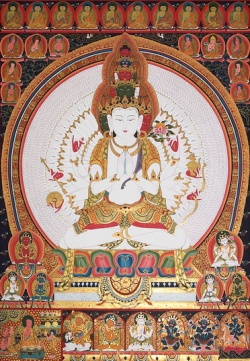Yarlung Kingdom - 237 BC - 842 AD
There were at least two early kingdoms in Tibet: ShangShung, Guge and Yarlung. The ShangShung appears to have been more of a culture zone than an actual "kingdom", so Tibetan history usually starts with the advent of of Buddhism under the Yarlung Kingdom. The exertions of Prinsep, Csoma de Koros, E. von Schlagintweit, and Sarat Chandra Das produced five lists of kings, forming the royal canon of Tibet from the legendary beginnings between the 5th and 2d century BC down to the end of the monarchy in 914. But the serious divergences which they show (except as to the later times and in general outlines) make their unauthentic character plain. As the last published list is accompanied by a commentary, it is the easiest to follow, and requires only to be supplemented here and there from the other lists and from the Chinese sources.
Nyatri was probably the first king to rule 'Bhot' when this appellation came into vogue. The Yarlung kingdom was the beginning of Tibetan history, established by the first King Nyatri Tsenpo It, possibly as early as 300 BC or as late as 127 BC. He was followed by 42 Kings, the last King being was Lang Darma, who was assassinated in 842 AD. By one account, in about 237 BC, a tribe by the Yarlung Tsangpo River was unified by Nyatri Tsenpo, the first king of Tibet. The first king, Gnya-khri btsan-po, is said to have been the fifth son of King Prasciiadjit of Kosala, and was born with obliquely drawn eyes. He fled north of tho Himalayas into the Bod country, where he was elected king by the twelve chiefs of the tribes of southern and central Tibet. He took up his residence in the Yarlung country south of Lhasa. This Yarlung, which borrowed its name from the Yalung of the state of Fanni Tu-bat, is a river which flows into the Yaro-tsanpo.
The first king and his six successors are known as the seven celestial khri; the next series consists of six kings known as the earthly legs; and they were followed by eight terrestrial Ide. This threefold sucession is apparently an imitation or a debased form of the ancient legend of heavenly, earthly, and human rulers, which was carried into Persia and China, and from the latter country into Japan and Tibet,— the relative number of kings being altered in the last-named countries to suit local convenience and the small amount of truth which they contain. While giving an Aryan descent to their first kings, the ancient Tibetans assigned to their princesses a divine origin, and called them lhamo, "goddess." The names of all these kings were formed by a combination of those of their parents, the mother's generally preceding that of the father. The Ide kings were followed by four rulers simply called btmn ("mighty").
Then occurs a break in the lineal descent in some of the king lists, and the king next in order (c. 461) may be the Tatar Fanni Tu-bat, but most probably bis son and successor. In the annals of the T'ang dynasty it is said that the population of the country originated from the Bat-Kian or Fah Kiang; and, as the information collected in the first part of the notice concerning Tu-bat, afterwards Tu-bau, the modern Tu-fan, dates partly (as is proved by internal evidence) from a time anterior to the T'ang dynasty (618 AD), some degree of reliance may be placed on its statements.
Fanni, a scion of the southern Liang dynasty of the Tu-bat family (which flourished from 397 to 415 atLiang-chu inKan-suh), who had submitted to the northern Liang dynasty, fled in 433 with all his people from his governorship of Lin-sung (in Kan-chu) westwards across the Yellow river, and founded beyond Tsih-shih ("heapy stones") a state amidst the Kiang tribes, with a territory extending over a thousand li. By his mild and just rule he was soon enabled to establish his sway over an immense territory. His original state was apparently situated along the upper course of the Yalung river, an affluent of the Kin-sha-kiang. The foregoing statements, which are most probably genuine history, are preceded in Tibetan chronicles by a mass of legends seemingly invented by the Buddhist historians for the purpose of connecting their monarchy with India.
The son and successor of the Tatar Fanni Tu-bat was Lhatho thori gnyan-btsan, otherwise Gnyan-btsan of Lha-tho thori, according to the custom usual in Tibet of calling great personages after the name of their birthplace. Lhatbo means "heaps of stones," and therefore appears to be a translation of Tsih-shih, "heapy stones," the country mentioned in connection with the foundation of a state by Fanni Tu-bat. It was during his reign that the first Buddhist objects are reputed to have reached Tibet, probably from Nepal.
Little is said of his three immediate successors. The fourth was gNam-ri srong btsan, who died in 630. During his reign the Tibetans obtained their first knowledge of arithmetic and medicine from China; the prosperity and pastoral wealth of the country were so great that "the king built" bis palace with cement moistened with the milk of the cow and the yak." To the same king is attributed the discovery of the inexhaustible salt mine called Chyang-gi-ts'wa 'Byang-gi-ts'wa= " northern salt"), which still supplies the greater portion of Tibet. The reign of his illustrious son, Srong btsan sgam-po, opened up a new era; he introduced Buddhism and the art of writing from India, and was the founder (in 639) of Lha-ldan, afterwards Lha-sa. </poem> www.globalsecurity.org
